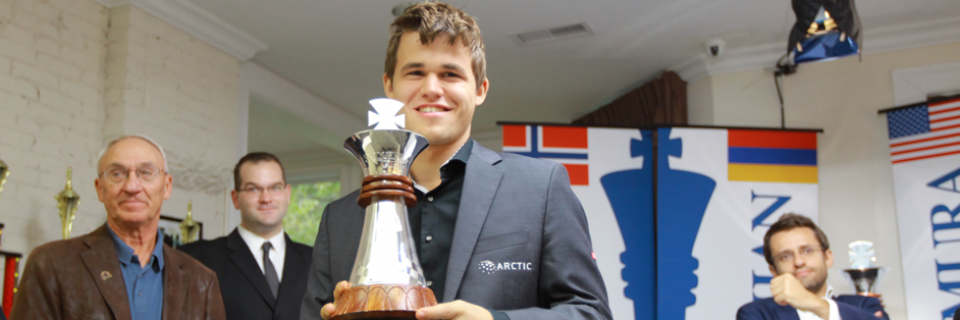Carlsen Wins Inaugural Sinquefield Cup in Style

Event sponor Rex Sinquefield and tournament organizer Tony Rich presented GM Magnus Carlsen the trophy for the inaugural Sinquefield Cup. World No. 2 Levon Aronian looks on.
By Brian Jerauld
Games annotated by GM Varuzhan Akobian and GM Ronen Har-Zvi
SAINT LOUIS (September 16, 2013) -- World No. 1 Magnus Carlsen brought home a $70,000 souvenir after his first visit to the United States: The country’s finest prize in chess, the Sinquefield Cup.
But he left America with an encore that made every last penny count.
With the showdown between U.S. No. 1 Hikaru Nakamura and reigning U.S. Champion Gata Kamsky already adjourned in a draw, Carlsen sat just a half-point away from the tournament’s top prize – and in front of a deadlocked board opposite World No. 2 Levon Aronian.
Aronian, trailing by a point, would earn third place and $30,000 regardless of a loss or draw – though a win promised playoffs. So he decided to probe the impossible-looking position while Carlsen, his own pieces frozen in tension, seemed content to wait the Armenian out. The white king moved idly back and forth on the back rank, waiting for Aronian to look the other way.
And he did – just the slightest. Aronian’s pressing, through a series of weakening king moves, tipped Carlsen just the smallest of advantages. And when Aronian decided he could find no way into the white camp, he offered a draw – and to everyone’s shock, Carlsen denied it. The half-point would have earned first place outright, $70,000 and the inaugural Cup, but Carlsen had found something much more valuable: the path to victory.
The win padded his lead to a full point (4.5/6), closing the strongest tournament on American soil with a dazzler. Nakamura (3.5/6) was forced to settle for the second place prize of $50,000 after his draw with Kamsky (1.5/6) on Sunday afternoon added no pressure to Carlsen.
“The final margin of victory was a little flattering,” Carlsen said.

World No.1 GM Magnus Carlsen declined a draw offer even though it would have guaranteed him clear first place. He went on to win his round 6 matchup agisnt World No. 2 GM Levon Aronian.
Aronian is a specialist in 1…e5, and his expert familiarity with the defense left him remarkably comfortable on the clock. Carlsen, however, would be struggling with the clock as the players neared the time control. Carlsen’s 14. Bc4 lost a step, and Aronian applied pressure immediately with 14…Ng4, forcing white to defend. Black’s position looked awkward (not aided by 16. Bxe6 fxe6, which doubled his pawns), but Aronian’s position had surprising potential.
His 28…Nbxa5 netted the game’s first material advantage, though the pawn grab came with a hint of poison as both knights and one of black’s rooks became locked in a defensive fortress, forcing the board into a near-static position. By 40. Kg1, Carlsen had worked himself out of time pressure and remained idle behind his own stout set up.
But after time control, despite no available pawn breaks and a host of immobile pieces for black, Aronian spent his extra time probing for weaknesses – a task that eventually weakened his own position. When he conceded that there was no path to Carlsen’s king, he offered a draw after 47…Kb7 – but received 48. Nd1 instead of the handshake.
Carlsen came quick with the attack, first relocating his cavalry to 51. Nc4. It pried open the black fortress and chased away both rooks with 52. bxc4 and 53. c5 before decimating the queenside pawns. Already on a slippery slope, Aronian made several more missteps down the stretch, including 54…b3, a move that did little more than sacrifice his knight with 55. Rxc6. The game was lost, though it continued into futility: Aronian resigned after 70. Ne5.
Carlsen-Aronian annotated by GM Varuzhan Akobian
Nakamura needed help from Aronian on the other board, but his final-round draw against Kamsky – a half-point that wasn’t easy to claim – didn’t help his own cause.
Seeking a full point, he answered Kamsky’s 1. e4 with the Najdorf, showing early aggression at 14…g4. The attack on the white castle seemed premature, however, with not much of black’s upper army seemingly ready to fight. Kamsky, showing a bit of polish after a rough week, had stuck to his principles with a king harbored in safety and a stout front line.
Though it is Nakamura who prefers the razor’s edge, Kamsky introduced some sharpness into the game with 19. f4 and 20. e5, looking to crack open black’s center line with its king still uncastled.
Nakamura’s 24…Qb6+ seemed a question mark in the American’s calculation, a first sign that a black victory was slipping out of view - and maybe worse on the horizon. But Kamsky let his advantage slip away with 29. Rd1?, not capitalizing on Nakamura’s distressed king, and the game soon adjourned in repetition.
Kamsky-Nakamura annotated by GM Ronen Har-Zvi
